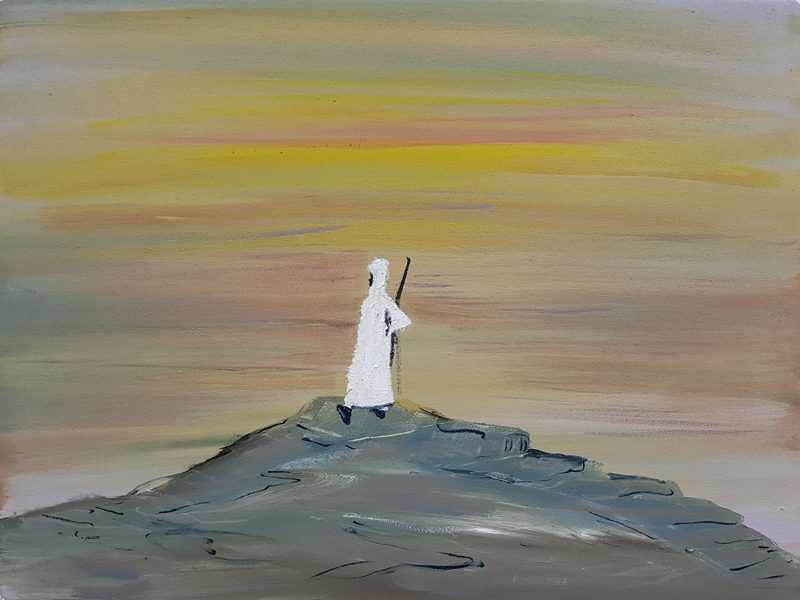
Oil on canvas, 45 x 60cm.
Photograph: © Shai Azoulay
An artistic exploration of triunital faith
I had Caspar David Friedrich’s famous painting of the Romantic period, Wanderer Above the Sea of Fog, in mind while creating this work, Living as a Pilgrim. Abraham, standing high on a hill, is looking out at the land through which he will be journeying. So much seems to be like a mirage, where there is promise but the vision is foggy; not everything is clear. The only way forward is to simply believe, a concept that cannot exist only in the mind, but beyond it. As a pilgrim, Abraham has to journey out in faith, forging ahead, knowing that he will need others along the way.
—Shai Azoulay
IN A WORLD gone completely mad, it is a relief and a wonder to know that there are peacekeeping organizations striving for the brotherhood of man at the most fundamental level of our existence: faith. More specifically, in today’s climate of increasing religious prejudice, which has resulted in protracted anti-Semitism and anti-Muslim sentiment, the capacity of creative initiatives has proven time and again to be the most powerful means in which to bring cohesion and universal consciousness to all. As Leonard Bernstein, 20th-century composer, conductor and musician, famously declared, “Art cannot change events. But it can change people. It can affect people so that they are changed—they then act in a way that may affect the course of events … by the way they behave, the way they think.”
The work of CARAVAN—an international peacekeeping nonprofit/NGO with the objective of building bridges through the arts between the creeds and cultures of the Middle East and West—is no stranger to The Culturium. Founded and curated by Rev. Canon Paul G. Chandler, their seminal exhibition focusing on the work of painters drawing inspiration from Kahlil Gibran’s The Prophet is one of the most popular pieces on the site.
CARAVAN’S latest presentation is one of their most pertinent to date: three celebrated Middle Eastern contemporary visual artists from the religious traditions of Islam, Christianity and Judaism (Sinan Hussein, Qais Al Sindy and Shai Azoulay) were invited to interpret artistically five important lessons taken from the Hebrew Bible, the New Testament and the Holy Qur’an, featuring the life of Abraham, “father” of the three monotheistic faiths: Living as a Pilgrim; Welcoming the Stranger; Sacrificial Love; Compassion; Friend of God.
Entitled “ABRAHAM: Out of One, Many” (a pun on the Latin, “E pluribus unum” / “Out of many, one”), the exhibition explores the way in which the life of the great ancestral patriarch can act as an exemplary example of how to live harmoniously and respectfully with those from different cultural beliefs and backgrounds, in a time period wherein we are all descendants of a shared spiritual heritage.
Living as a Pilgrim
“I am not from Africa, nor from Europe, nor from Arabia …
but I come from no country, from no city, no tribe.
I am the son of the road, my country is the caravan,
my life the most unexpected of voyages.”
—Amin Maalouf, “Leo Africanus”
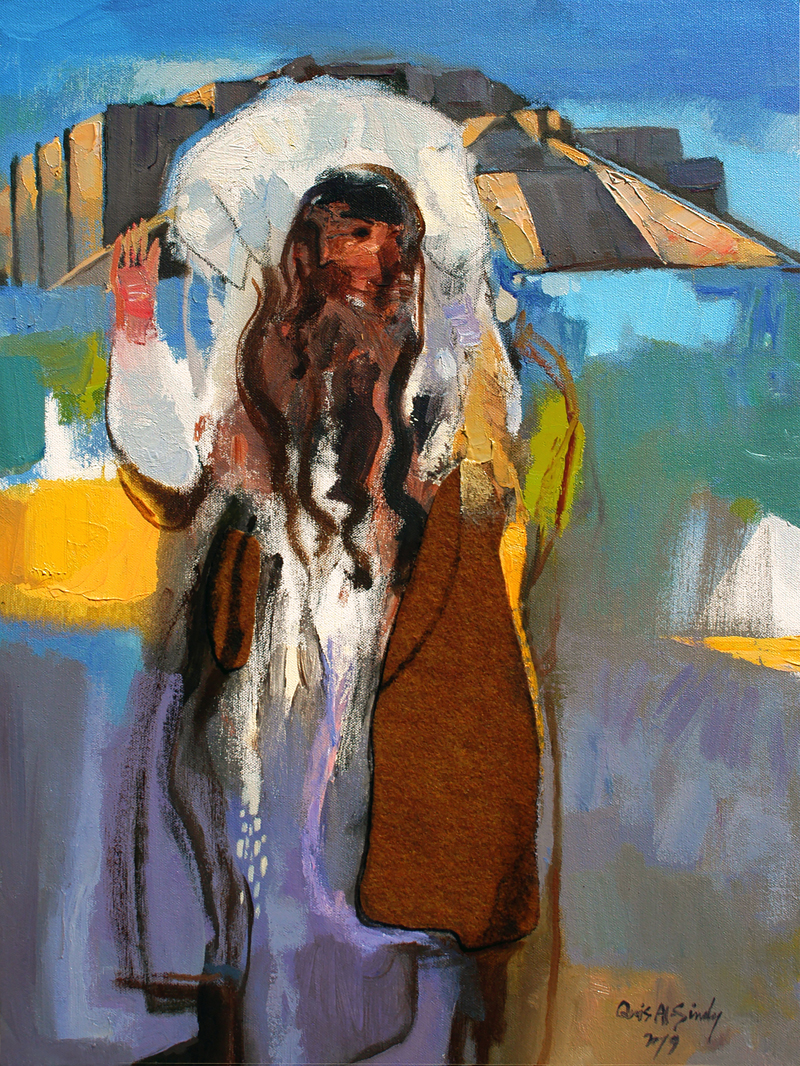
Oil and collage on canvas, 60 x 45cm.
Photograph: © Shai Azoulay
I left my land, my land did not leave me …
Abraham begins his pilgrimage from Ur of the Chaldees, which is now called Nasiriyah in the Dhi Qar governorate of southern Iraq. This is where the Great Ziggurat of Ur was built by Ur-Nammu, the Sumerian king. As he travelled throughout foreign lands, he lived harmoniously among their peoples.
I painted Abraham carrying a sheep on his shoulders because I see him as a shepherd leading his people to the land God promised him and his offspring. In Iraq, I bought an old Nasiriyan shepherd’s cloak made of sheep’s wool, cut it into pieces and pasted some of them on these canvases to give shape to Abraham’s clothes. I wanted to bring the spirit and soul of this great prophet through the material of his native land.
I also depict the Ziggurat as a burden on his shoulders because he carries his land with him in his heart as he journeys. The white pyramid on his left is a foreshadowing of his journey into Egypt and of what will happen to his offspring.
—Qais Al Sindy
In the programme notes to this groundbreaking project, Paul-Gordon Chandler outlines the biographical life of the great prophet, who lived approximately 4,000 years ago: “Abraham/Ibrahim/Avraham, whose name means ‘father of many’, is the most jointly beloved figure by Jews, Christians, Muslims and Druze, who all see themselves as proud descendants of this wandering Aramaean—as ‘children of Abraham’. Jews identify Abraham as their founding father, Christians trace the lineage of Jesus Christ back to him, and Muslims revere him as a friend of God, a father of the prophets, and an ancestor of the Prophet Mohammed.”
According to the biblical Book of Genesis, Abraham’s father Terah, a descendant of wandering Semitic tribes, moved his three sons and their families north, from the ancient imperial capital of Sumer, Ur, to Harran, another city-state along the Euphrates River, close to modern-day Syria. Here, it is said that Abraham (Abram) heard the word of God speak directly to him to leave his country and his people and his father’s household to live the life of pilgrimage, whereupon he journeyed throughout the Middle East for the rest of his days in the spirit of universal embrace and openness toward all humankind.
Welcoming the Stranger
“Your neighbour is your other self dwelling behind a wall.
In understanding, all walls shall fall down.”
—Kahlil Gibran
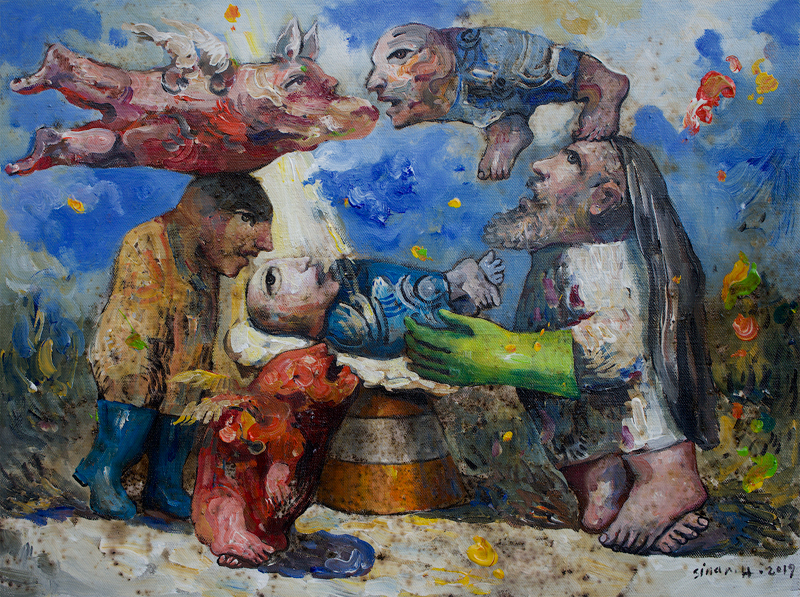
Mixed media on canvas, 45 x 60cm.
Photograph: © Sinan Hussein
My paintings frequently blend the contemporary with the historical. In this painting, Abraham and Sarah are welcoming Ishmael into their lives. Outside of Islam, Ishmael is very often viewed as secondary in importance, and therefore not always universally accepted. So, in this painting, he is representative of ‘the other’. God is sending down a blessing upon Ishmael’s head. The sky is full of celebration. The figures are celebrating, representing angels and souls, flying souls, and as they are not human, they can take on different forms and change shapes. The cone is a symbol I often use to represent a very personal or sacred moment. As when cones are set up to block off something, preventing public access, so here it is symbolic of an inner experience, a deeper dimension. I use the green glove here to portray an extremely positive moment, as it is a sacred colour in Islam. Welcoming the stranger, ‘the other’, is to be embraced and celebrated.
—Sinan Hussein
Paul-Gordon Chandler continues: “From Harran, Abraham ventures forth with his wife Sarah (known as Sarai at the time), his nephew Lot and a caravan of livestock and servants. He ends up in Canaan (southern Levant) until famine strikes and he journeys to Egypt for food. This is when the more familiar stories of his life unfold: the heroic rescue of his nephew Lot; the birth of Ishmael through Hagar; the welcoming of the angelic strangers in the desert with promise of the miraculous birth of Isaac through Sarah; his compassionate pleading with God to spare innocent lives in Sodom and Gomorrah; his willingness to sacrifice his son, Isaac, and then God’s provision of a ram to spare his son’s life.”
It is indeed a paradox of contemporary living that on the one hand, the diversity of culture has never been more celebrated, with minority groups given even greater legal status in terms of fundamental rights and freedoms, and yet on the other, ethnic prejudice, gender inequality and religious intolerance have reached pandemic proportions across the globe. The edict to “welcome the stranger” could not be more timely.
Sacrificial Love
Just as a circle embraces all that is within it, so does the Divine embrace all.
No one has the power to divide this circle, to surpass it or to limit it.
—Hildegard von Bingen
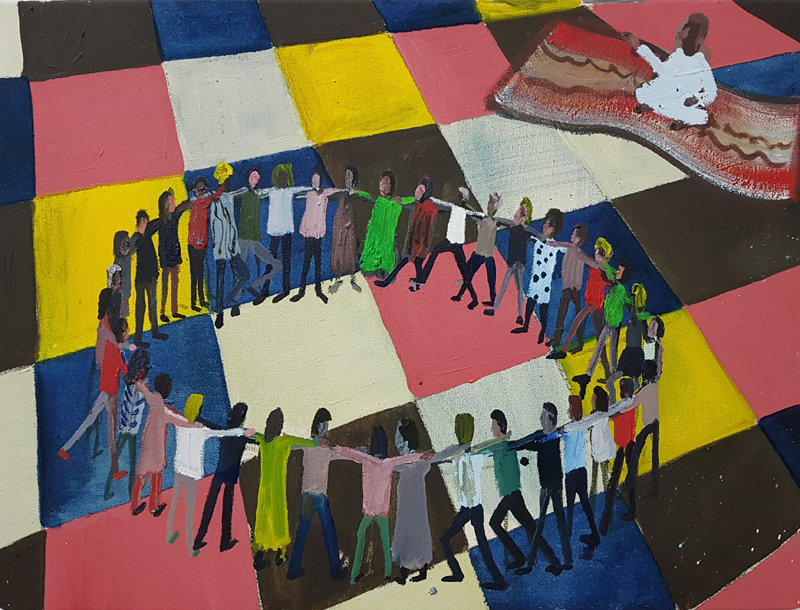
Oil on canvas, 45 x 60cm.
Photograph: © Shai Azoulay
In this work about Abraham’s sacrificial love for God and others, I show the patriarch Abraham on a flying carpet observing a large circle dance whose participants illustrate the diversity of our world. Circle dancing is very much part of Jewish culture. For me, the circle represents something that connects people from all backgrounds and breaks down all walls. In a circle, we become one.
—Shai Azoulay
Abraham consistently demonstrated “sacrificial love” throughout the course of his life, the most infamous example being the “Binding of Isaac”, in which the patriarch is commanded by God to sacrifice his own son as a test of his allegiance. When Abraham complies, God sends him a ram to sacrifice in his place.
To modern wayfarers, the ritual slaughter of a family member is a perplexing tale from which to take inspiration and yet if we think of a parallel mythological narrative in the Hindu Bhagavad Gita, wherein Sri Krishna urges Prince Arjuna to take up arms against his own clan, we can perhaps gain a deeper appreciation for the need to trust the divine power that knows the way through acts of duty and obedience, despite how they may appear on the surface. Interestingly, in the Qur’an, the story of Isaac’s sacrifice is told as a dream or vision, reiterating the metaphorical, rather than literal, truth of the story.
Compassion
“Be a lamp, or a lifeboat, or a ladder. Help someone’s soul heal.
Walk out of your house like a shepherd.”
—Jalal al-Din Rumi
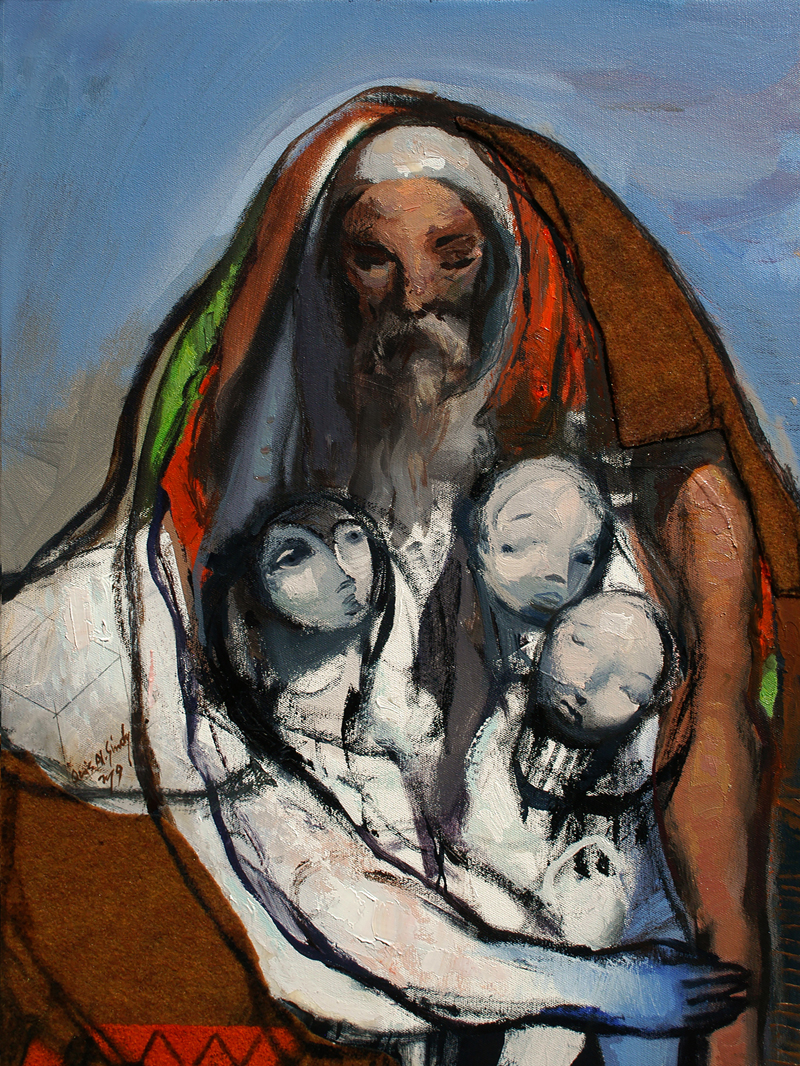
Oil and collage on canvas, 60 x 45cm.
Photograph: © Shai Azoulay
He is my stronghold; of whom shall I be afraid?
Sodom and Gomorrah are synonymous with human depravity and their subsequent fall was a legendary manifestation of divine vengeance. In the Book of Genesis, Abraham pleaded with God to spare the city if a certain number of righteous people were found. In this painting, Abraham’s long arms are a sign of compassion and protection as he embraces three children, representing the three Abrahamic religions. With such an intrinsic and universal link among these religions, I trust there will be greater tolerance and acceptance of others.
—Qais Al Sindy
Regardless of who someone is or what they have done, Abraham exhibits the deepest compassion for others, none so emphatically exemplified by his repeated pleading to God to spare the lives of the inhabitants of Sodom and Gomorrah, whose heinous acts are sadly still witnessed today in our modern age.
As an aside, I am reminded of the black and white film version of Charles Dickens’ immortal classic, A Christmas Carol, in which the Ghost of Christmas Present shows Scrooge two children—Ignorance and Want—who are hiding under its cloak, serving as an arresting warning to Scrooge to change his diabolical ways. Indeed, the power of visual metaphor to hold up a mirror to the problems of contemporary society is one which painters, filmmakers and artists have intuitively understood from time immemorial, none so beautifully executed in CARAVAN’S auspicious exhibition as the year finally comes to a close.
Friend of God
“Our task must be to free ourselves by widening our circle of compassion to embrace
all living creatures and the whole of nature and its beauty.”
—Albert Einstein
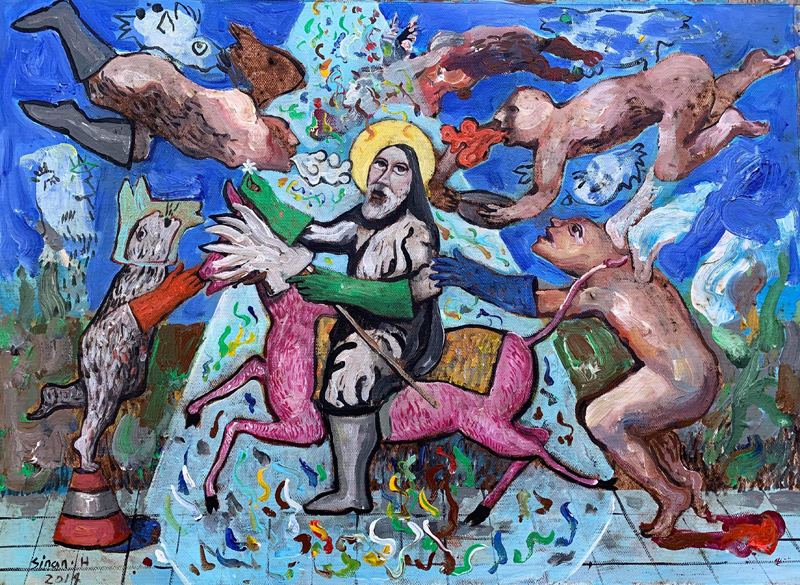
Mixed media on canvas, 45 x 60cm.
Photograph: © Sinan Hussein
This painting is a celebration of life. All the earth, people, creatures, vegetation and animals come together for a festival around Abraham. God has sent a pink horse, a sign of celebration, for his friend, Abraham, to ride on in this great festival of life. Because Abraham embraces all that God has created, people throughout the whole world never stop praising his name. The earth is alive, and the face of the souls all around him are in a state of ecstatic joy. Even a cat’s face has taken on the appearance of a dog, in the glorious embrace of all things. Abraham’s green gloves symbolize God’s endorsement and pleasure. Everything is swimming around Abraham as he blesses all on this sacred earth.
—Sinan Hussein
The sacred scriptures of Islam, Christianity and Judaism refer to Abraham as a “friend of God” and all that he holds dear in life—people, flora, fauna, indeed the entire manifested universe itself. And it is through the bold and impassioned pictures of these exceptional visual artists that Abraham’s spiritual inheritance may be communicated to all who encounter their captivating work.
To return once again to the great Leonard Bernstein: “A work of art does not answer questions, it provokes them.” Indeed, for if the questions remain unuttered, let alone unanswered, our future as a species is surely doomed to a state of unconscious oblivion. It is our noble duty, therefore, to champion our fellow creatives—through the work of CARAVAN and others—who nobly carry Abraham’s spiritual legacy for the continuation of love, peace and harmony upon the face of this most blessed earth.
Artists’ biographies
SINAN HUSSEIN was born in 1977. His artistic legacy extends from the vision of his Mesopotamian ancestors and its vast civilization and splendorous history to the challenging present. The silent discourse, the gaze of his figures and the unusual objects in his paintings are a living metaphor from the past. At the age of 14, Sinan practised art by sketching portraits of his friends and family. His artist and musician father recognized his talent and encouraged him to continue his art journey, first with several years of self-study, observing the classic, modern and contemporary artists.
Sinan then obtained his BFA at the University of Fine Arts in Baghdad. Soon after graduation, in 2004, he left Baghdad because of the war and the sectarian violence that almost ended his life three times. He found refuge in Kuwait and eventually in the United States. The nostalgia of Sinan’s homeland and search for a new home have enriched and shaped his paintings. He has participated in many highly acclaimed solo and group exhibitions in the Middle East, Europe and the United States. His artwork is collected by Middle Eastern and Arab royalty, governments and private collectors around the world. He is a member of the Iraqi Fine Arts Artist Society and The Union of Iraqi Artists. Sinan is from a Muslim background.
QAIS AL SINDY was born in Baghdad, Iraq in 1967 and has a BSc degree in Engineering (1989) as well as a BFA (2000) and an MFA (2004) from the Academy of Fine Arts at Baghdad University. In Amman, Jordan, where he lived for four years, Qais taught “Art in Architectural Engineering” at the University of Applied Science. Beginning with his first major exhibition titled “Letters Don’t Burn,” which was about the burning of the Iraqi library, he has exhibited around the world on themes related to humanity, culture and civilization, winning numerous distinguished awards. Qais is of Chaldean Christian heritage and now lives in San Diego, California.
SHAI AZOULAY studied at the Bezalel Academy of Art and Design, where he received both his BFA and MFA. In his paintings, Shai creates a narrative abundant with figures and scenes that radiate human warmth, compassion and slight irony. His work ranges between drawing and painting, between the sophisticated and the naive, and between the omnipotent to the limited. As such, the work addresses the two conflicting worlds found in the mind of the contemporary painter—the classic, iconic, romantic and spiritual world, on one side, and the modern, moonstruck and saturated world on the other.
Azoulay has held numerous solo exhibitions and has exhibited in the Tel Aviv Museum, Frieze Art Fair, and around the world, from Tokyo to Rome, Paris and New York. He is the recipient of the “Morasha” Award from the Tel Aviv Museum of Art and The Moses Prize from the Jerusalem Artist House. His works are in renowned collections around the world. Shai is from the Jewish faith tradition.
Post Notes
- CARAVAN
- Rev. Canon Paul G. Chandler’s website
- SYMBOLS OF LIFE: Beyond Perception
- Kahlil Gibran: Poet, Painter, Prophet
- GROUNDED: Native American Contemporary Art
- Hafiz: The Gift
- Hady Boraey: Line of Descent
- Philip Jacobs: Dance of the Dervishes
- Carl Gustav Jung: The Red Book, Liber Novus
- William Blake: All Religions Are One
- Patrick Howe: Post-Personalism in Art
- Nicholas Roerich: Beautiful Unity
